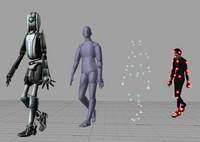
Photo from wikipedia
Abstract Ru nanoparticles supported on perovskite NaNbO3 with cubic crystal structure and nanoflower-like morphology was prepared by a convenient solvothermal method combined with photo-deposition technique. Crystal structure, chemical component and… Click to show full abstract
Abstract Ru nanoparticles supported on perovskite NaNbO3 with cubic crystal structure and nanoflower-like morphology was prepared by a convenient solvothermal method combined with photo-deposition technique. Crystal structure, chemical component and surface valence states determined by XRD, XPS, TEM and SEM demonstrated the metastable cubic phase of perovskite NaNbO3, and its modified surface by Ru species. Optical and electrochemical analysis, such as UV–vis DRS, OTCS and EIS, indicated the excellent photoelectrochemical properties and the efficient electron transfer of the composites. Compared with naked and Ru-doped NaNbO3, the composite photocatalyst exhibited outstanding performance for the degradation of RhB under visible light irradiation due to the dye self-photosensitization and the surface interaction between Ru metal nanoparticles and semiconductor. In-situ reduction of surface Ru oxide species in the photocatalytic process assisted the further improvement of the photocatalytic activity and stability. Investigation of the main active species during the photocatalysis confirmed the efficient transfer of the photo-generated electrons and the positive effect of oxygen defects in NaNbO3. Finally, possible mechanism of the present visible-light driven photocatalysis was proposed in detail. This work provided an alternative strategy to enhance the visible-light photocatalytic efficiency of the catalyst with wide band gap on the basis of the synergistic effect of dye self-photosensitization, interaction between NaNbO3 and its surface Ru nanoparticles, and the “self-doping” of oxygen defects in NaNbO3.
Journal Title: Applied Surface Science
Year Published: 2018
Link to full text (if available)
Share on Social Media: Sign Up to like & get
recommendations!